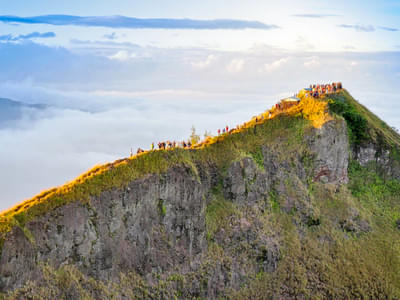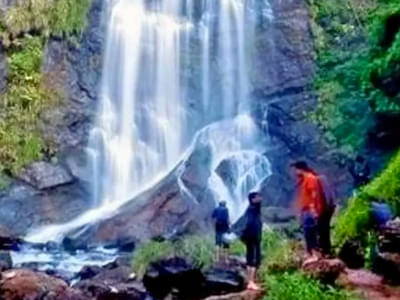About Hemis Monastery
While exploring the monastery, you will admire a remarkable display of traditional Tibetan architecture, including vibrant murals, intricate wood carvings, and a towering statue of Lord Buddha adorned in copper and gold. The monastery has an expansive courtyard, providing a tranquil space for meditation. You can see a treasure trove of ancient artefacts, including thangkas (religious paintings), statues, and sacred relics as you visit its inner areas.
One of the highlights of this famous monastery is the vibrant Hemis Festival, celebrated annually to honour Guru Padmasambhava, the revered 8th-century Buddhist master. During the festival, you can enjoy music, dance, and religious ceremonies and learn about Ladakh's rich cultural heritage. Surrounded by the majestic Himalayan mountains, the monastery also provides opportunities for outdoor adventures like trekking, meditation retreats, and cultural immersion experiences in the nearby villages.
Hemis Monastery Highlights
• Step back in time and visit the Hemis Monastery, founded in the 11th century by King Senge Nampar Gyalva and has a rich history dating back over 1,000 years.
• Explore the vast collection of ancient Tibetan artefacts, including thangkas (scroll paintings), statues, and sacred relics, and learn about the region's spiritual legacy.
• Be amazed by the traditional Tibetan architecture of the monastery, including intricate design features colourful murals, ornate woodwork, and a massive copper-gilded statue of Lord Buddha.
• Enjoy the breathtaking views of rugged mountains, tranquil valleys, and Himalayan landscapes while exploring this famous Buddhist monastery on the bank of the Indus River.
• Attend the vibrant and colourful Hemis Festival hosted by the monastery, which is celebrated in honour of the birth anniversary of Guru Padmasambhava, the founder of Tibetan Buddhism.
How To Reach Hemis Monastery
1. By Air: The closest airport to Leh is Kushok Bakula Rimpochee Airport, which is connected to several major Indian airports. To get to your hotel in Leh, you can take a taxi from the airport, and then arrange a day excursion from Leh to Hemis Monastery and other surrounding sights.
2. By Road: You can use a taxi or a bus to get to Ladakh, or you can drive your own car or bike to Hemis. To get to the monastery if you're coming from Srinagar, you can take the Leh-Srinagar highway.
3. By Train: Jammu Tawi, the nearest railway station to Leh, is 812 kilometers away. To go to Leh from the train station, simply call a taxi. With overnight stays in both Srinagar and Kargil, the trek takes three days to complete. As previously said, after you arrive in Leh, you can take a taxi to the Hemis Monastery.
Best Time To Visit Hemis Monastery
Hemis Monastery is a year-round destination to explore. This a Himalayan Buddhist monastery where you can see a range of ancient artefacts and sacred relics at any time of the year.
1. Best Season: You can visit Hemis Monastery during the summer season, from June to September, and enjoy pleasant weather while exploring the monastery and its surrounding areas.
2. Best Day of the Week: You can visit the monastery on weekdays, especially Mondays and Thursdays as you will find fewer crowds as compared to weekends.
3. Best Time of Day: You can visit the monastery in the early mornings or late afternoons as these times are ideal for photography and meditation.
Hemis Monastery Other Essential Information
Tips to visit
1. To acclimate to the severe environment of Ladakh, you should get as much rest as possible on your first day there.
2. To keep your skin safe from the sun's harmful rays, use a high-quality sunscreen before going outside.
3. To visit the monastery, visitors do not need Inner Line Permits. To enter the monastery, you'll need to purchase a ticket.
4. You must adhere to the monastery's dress code and adhere to the monastery's regulations.
5. You can leave your cell phone and camera in the monastery museum's lockers while you explore the collection.
6. From the gompa, you may capture breathtaking panoramas on film. You should acquire permission before photographing any monk in the monastery.
7. Sign up for a postpaid number with BSNL, Jio, or Airtel, as other networks do not perform properly in Ladakh.
8. If you're planning a trip to Leh, Ladakh during the high season, book your flights early to avoid price increases.
Places to visit nearby the monastery
1) Guru Lhakhang: Drukchen suggested that the Guru Lhakhang be built in 1985 and in lieu of a temple that had been demolished, this new structure was created, with the ceiling partially collapsed. The courtyard leading to the porch, where a stairwell leads to the Guru Lhakhang, provides entrance to the hall. In the Guru Lhakhang, Tsering Wangdus painted a massive statue of Guru Padmasambhava, and Nawang Tsering erected it.
2) Sacred Hermitage: Gyalwa Kotsang built a sacred hermitage about three kilometres from the monastery grounds. The colourful Buddhist flags adorning the cave contrasted well with the rough rocks. On the rocks of the cave, you will discover the hand and footprints of Gyalwa Kotsang.
3) Thiksey Monastery: Thirteen stories high, Thiksey monastery is situated at an altitude of 11,800 feet. There are various Buddhist artefacts found here, including thangkas, stupas, wall murals, sculptures, and swords. The Maitreya Temple is one of the monastery's most prominent attractions as a massive statue of Maitreya Buddha can be found inside of the temple, which spans two storeys and is 15 metres tall.
4) Stakna Monastery: The Stakna Monastery, a Buddhist retreat on the banks of the Indus River, is linked with the Drukpa Sect. The monastery is known as "Stakna" because of its hilltop location, which resembles the nose of a tiger. Located at an elevation of 11,800 feet, the Stakna monastery affords spectacular views of Hemis monastery and its environs.
5) Shey Monastery and Palace: The Shey Monastery and Palace are a must-see when in Leh, Ladakh, because they have so much to offer visitors of all types. The enormous statue of Shakyamuni Buddha and the picturesque site of the monastery in Stok, which is surrounded by snow-capped mountains, attract a large number of people from around the globe. The monastery is well-known not just for its stunning design, but also for the breathtaking views it affords from the vantage point from which it was erected. From here, it's possible to have a bird's eye view over the Indus Valley and Indus River as far as the settlement of Stok.
Hotels nearby
1) Hotel Lotus: The Hotel Lotus, nestled under poplar trees and lush green lawns, has all the modern conveniences at a reasonable price. It's easy to get to Hotel Lotus from any part of Leh thanks to its location on Upper Karzo Road. Nearby attractions and shopping malls make it an ideal location for visitors to the city of Leh.
2) Hotel Omasila: Your stay at the Hotel Omasila will be a memorable one in this extraordinary Himalayan Kingdom. Taking a break from the hustle and bustle of the city and breathing in some fresh air will help you relax. Located in a gorgeous area, Hotel Omasila, which is only a 15-minute drive from Leh's airport and close to the market, offers stunning views of the Himalayas.
3) Lha-Ri-Sa resort: Located in Ladakh, Lha-Ri-Sa Boutique Hotel offers a unique blend of comfort and eco-consciousness with modern conveniences. You'll be enchanted by the snow-capped Zanskar ranges while you relax in shady poplar trees.
Monastery Courtyard
A short distance later, you will arrive at the monastery's main courtyard. It is impossible not to be captivated by the breathtaking panoramas of the surrounding mountains and countryside as there are multiple buildings surrounding the courtyard, giving it plenty of space.
Prayer Hall of the Monastery
Tibetan paintings on silk cloth representing deities or mandalas are known as Thangkas, and the prayer hall featured an impressive collection of them. Thanks to its enormous size, one of the monastery's Thangkas could only be presented once every 12-years or so.
Monastery Museum
Buddhism's most famous artwork, artefacts, and weaponry are all on display at the museum. The most attractive feature of it is that it is nicely illustrated, displaying numerous monastic artefacts. There is a tiny shop on the ground level of the museum where souvenirs including t-shirts, books, and other items are sold.
The Nyingma Lhakhang Temple
With a history dating back over a thousand years, it is the most important portion of the monastery. The courtyard in front of the temple's main entrance leads to the Nyingma Lhakhang. Beautiful spring water flows from the courtyard, and a wood shop houses willow stumps. Kitchen and other support structures are linked to the Nyingma Lhakhang. There are two statues of Tara and Stagsan Raspa in the Nyingma Lhakhang. Various Buddha-themed artwork, murals, and paintings decorate the chamber. Nyingma Lhakhang's paintings had to be repainted in 2015 after some were damaged by water seepage.
Dukhang Barpa
In the centre of the prayer halls is the Dukhang Barpa, and only special occasions need the employment of this room. From the courtyard, there is a stairway that leads to the porch, from where one can enter the hall. Four wooden pillars support the porch and its balconies with the three-tiered ceiling that is supported by slender wooden pillars in the hall. For the Hemis Festival, it serves as a dressing room and waiting area for the performers, and also features a large Shakyamuni sculpture and statues honouring Gyalra Rinpoche, Stagsan Raspa, alongside countless stupas.
Dukhang Chenmo
Stagsan Raspa and Drukchen take their places in the prayer hall known as the Dukhang Chenmo. It's interesting to compare the paintings in this room to those in the Nyingma Lhakhang as some believe they symbolise the distinctive artistic sensibilities of Ladakhi artisans as deities and lineage masters. In the monastery, it is one of the most prominent places to be because the Drukchen and Stagsan, as well as other gods and masters, are honoured in this place through sacred rites and invocations of their namesakes.
Visitors’ Gallery
Because of water seepage damage in several areas, the gallery was completely reconstructed in 1996. To accommodate more people, however, the gallery's size had to be altered. The Gersang Hermitage's collection of notable paintings and reliefs are on display in the gallery. Sculptures, woodblocks, metal artefacts, manuscripts, and decorated textiles were once displayed in the gallery but have since been relocated to the museum at the other end of the space.
The Hemis Festival
To commemorate Guru Padmasambhava's birth, Ladakh's Hemis Festival is one of the most significant Buddhist celebrations as well as a top tourist attraction. Festivities at Hemis Gompa, Ladakh's most-visited monastery and an important Buddhist shrine, are held for two days each year in June/July (the fifth and tenth days respectively). During this annual event in Ladakh, the Hemis Monastery hosts performances of the Cham Dance and other folk dance performances to the sounds of drums, cymbals, and a long pipe-like Tibetan musical instrument. There will be public unveilings of massive thangkas (Buddhist artworks) on both days. In reality, on the festival's first day in Hemis, the biggest thangka in Ladakh is displayed to the public every 12 years.
Explore Dukhang (Assembly Hall)
In the Hemis Monastery, the Dukhang, or Assembly Hall is the central gathering place. The hall serves as the focal point for religious ceremonies and communal activities. While stepping inside the hall, you will be amazed by its serene atmosphere and richly adorned interior. You can see the wonderful Tibetan architecture, with intricately carved wooden pillars, colourful murals, and a beautifully crafted altar. You can also find a range of sacred artefacts, including ancient thangkas (scroll paintings), statues of Buddhist masters, and ceremonial objects. It is a place where monks gather for daily prayers, chanting and meditation sessions. You also get a chance to see these spiritual ceremonies and Tibetan Buddhist practices.
Tourism Board Alliances
Hemis Monastery Reviews







.jpg?w=1280&dpr=1)







.jpg?w=1280&dpr=1)
.png?w=1280&dpr=1)
.jpg?w=1280&dpr=1)
.png?w=1280&dpr=1)



